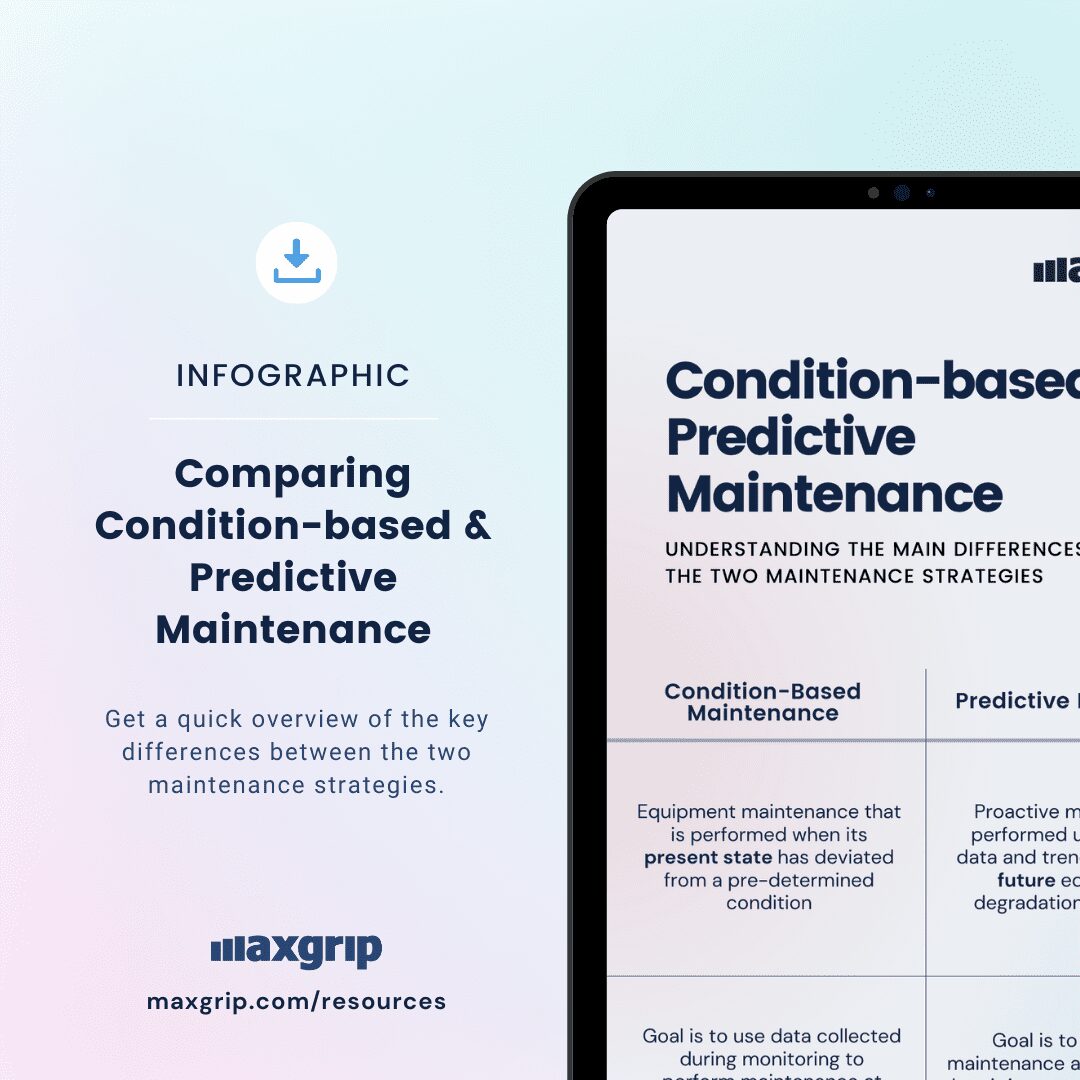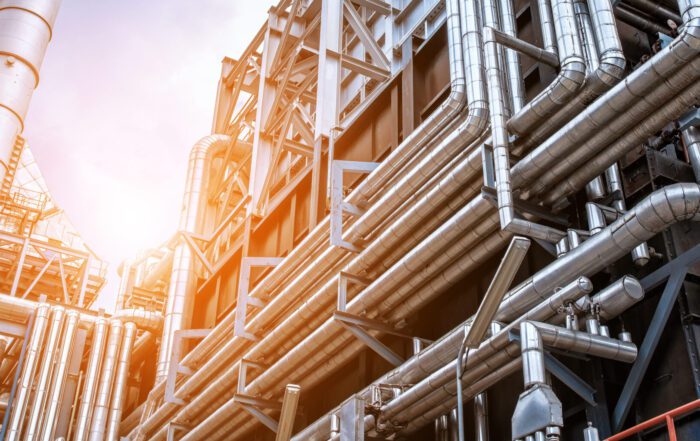Condition-based maintenance and predictive maintenance are maintenance strategies that both use data and measurements to assess the condition of an asset and uses this assessment to proactively prevent a equipment failure. These strategies are commonly used in the chemical industry, particularly in predictive maintenance chemical industry, to improve asset integrity through predictive maintenance techniques.
Though both strategies have some overlap, there are key differences in how they capture and use data to inform decision-making. Condition-based maintenance uses data collected during monitoring to perform maintenance at the exact moment it is needed and before a critical failure occurs, while predictive maintenance uses aggregated sensor data and trends to predict future equipment degradation and failure. The maintenance team is responsible for implementing these strategies, through a condition based maintenance program, and using tools such as oil analysis to inform their decisions.
Advantages of condition-based maintenance include minimizing downtime, avoiding unnecessary maintenance, and improved productivity. However, it also has limitations such as inconsistent information and the possibility of under-maintaining or over-maintaining the equipment.
Predictive maintenance, on the other hand, uses machine learning algorithms to build more accurate predictions over time and does not rely on a single data point. It can help to reduce maintenance costs and improve the efficiency of maintenance teams by allowing them to focus on the most critical tasks.
Overall, both condition-based maintenance and predictive maintenance play an important role in maintaining and improving equipment performance, and a combination of both strategies may be the most effective approach. Reliability centered maintenance and predictive maintenance training are also important topics to consider when implementing these strategies, as they can help optimize operating costs and increase efficiency.
What is Condition-based Maintenance?
Though condition-based maintenance and predictive maintenance strategies have some overlap in the tools or methods used, they are not technically the same.
Condition-based maintenance is equipment maintenance that is performed when its present state has deviated from a pre-determined condition. The goal behind this approach is to use the data collected during monitoring to perform maintenance at the exact moment it is needed and before a critical failure occurs.
For example, if an oil pump measurement shows a drop in pressure, that would indicate that the equipment needs maintenance work. The idea is to use condition monitoring to perform maintenance at the exact moment it is needed and before a critical failure occurs.
Condition-based maintenance uses these methods to monitor equipment condition
- Visual inspections
- Instrument measurements
- Sensor readings
Condition-Based Maintenance Advantages and Disadvantages
Advantages of Condition-Based Maintenance
One of the clear benefits of condition-based maintenance is that necessary maintenance can be performed on critical equipment in a way that minimizes downtime. That leads to more reliability in the uptime and production of the equipment.
Another advantage is that it helps avoid distributing and prioritizing work hours on equipment that does not need it or is not critical. That time and effort can instead be used on tasks and projects that can drive the overall business.
Finally, it creates efficiency and improved productivity because work can be planned and scheduled during non-peak hours.
Disadvantages of Condition-Based Maintenance
One of the main limitations to condition-based maintenance is the possibility of inconsistent information since the analysis is up to the discretion of whoever is performing it. That includes how the data is collected, how the measurements are read, and the accuracy of the tools used.
Further, acting on readings that do not capture the full picture can result in under-maintaining or over-maintaining the equipment, leading to wasted parts and hours.
Condition-based maintenance is a simple approach that relies on human factors for its execution and success. It does not have the predictive intelligence which makes predictive maintenance alluring.
Summary of condition-based maintenance
Condition-based maintenance is a simple approach to help proactively monitor the condition of a critical asset and to inform decision-making as it relates to its performance.
However, this simple approach misses out on more advanced “predictive” tools and could potentially lead to equipment that is under-maintained or over-maintained.
What is Predictive Maintenance?
Predictive Maintenance is a proactive maintenance strategy that uses aggregated sensor data and trends to predict future equipment degradation and failure. The goal behind this approach is to schedule asset maintenance at a future time when it is more convenient and will have minimal impact on production.
A good example of a predictive maintenance strategy in practice would consist of having an industrial pump serviced based on readings from multiple data points such as its pressure delta, vibration, and flow rate capacity. When any of these points deviate from the control limit, which the algorithm develops over time, it will begin to notify that the equipment will require maintenance soon.
The point – a predictive maintenance approach does not rely on a single datapoint, it looks at all data trends in context with the operation.
Types of Predictive Maintenance
There are several types of predictive maintenance, each with its own advantages and disadvantages. The most common types of predictive maintenance are:
- vibration monitoring
- oil analysis
- thermography
- ultrasound
Vibration monitoring is used to measure the vibration levels of machinery, which can indicate when a component is beginning to wear or break down.
Oil analysis can detect the presence of contaminants in the oil, which can be a sign of wear or damage.
Thermography is used to detect temperature changes, which can indicate when parts are under excessive strain or running too hot.
Lastly, ultrasound is used to detect subtle changes in the surface of machinery and equipment, which can be indicative of wear or damage.
Predictive Maintenance Advantages and Disadvantages
Advantages of Predictive Maintenance
The benefits of implementing predictive maintenance can potentially outweigh its limitations.
A clear advantage of predictive maintenance is that, thanks to predictive maintenance technology the machine learning algorithms, its readings and predictions get more precise over time. That information contributes to actionable data insights, which has a direct impact on maintenance prioritization and budgeting.
Another key benefit is that it uses equipment data trends to learn from patterns to inform the prediction model. That prediction model is what helps to detect a breakdown rapidly and accurately prior to any obvious indications. Meaning that, unlike condition-based maintenance, there is more accuracy as time goes on with far less reliance on human action or interpretation.
An added benefit we see in predictive maintenance best practices is that it can contribute to minimizing the total cost of ownership (TCO) of an asset as work is performed proactively, thereby potentially extending the life of critical assets and improving productivity.
Disadvantages of Predictive Maintenance
As with any strategy, predictive maintenance has its own set of limitations.
A potential limitation is the large initial investment in all the technology needed to make it effective, such as equipment sensors, software, and other tools. The tools and software will need to be implemented and employees will need to be trained. It is worth considering if the return on investment will be adequate based on the equipment’s use case and, more importantly, its criticality. An equipment that would potentially bleed millions of dollars per hour during a equipment failure could be well worth the investment.
Another limitation is that it takes time for the predictive analytics to gather the historical data trends necessary to make the data points actionable. Although it gets smarter over time, it requires time and that is also an investment.
Summary of Predictive Maintenance
Predictive maintenance uses multiple data points to forecast future maintenance work or potential failure.
Although predictive maintenance strategy may require a higher initial investment, but its predictive intelligence can be a tremendous advantage in conducting prompt, proactive maintenance on critical equipment which will, in turn, extend its useful life and improve reliability.
Key Takeaways condition-based maintenance (CBM) vs predictive maintenance
Condition-based maintenance
- Uses data collected during monitoring to perform maintenance at the exact moment it is needed and before a critical failure occurs.
- Helps avoid allocating and prioritizing work hours on equipment that does not need it or is not critical
- Uses visual inspections, instrument measurements, and sensor readings to monitor an equipment’s state
Predictive Maintenance
- Uses aggregated sensor data and trends to predict future equipment degradation and failure
- Does not rely on a single datapoint, it looks at all data trends in context with the operation
- Uses machine learning algorithms to build more accurate predictions over time
📊 Download free eBook about preventive maintenance
📰Continue Reading
- Using Data Insights to Strengthen Your Organization’s Maintenance Strategy
- How business context can influence asset performance benchmarks
- Reliability Metrics: Mean Time Between Failure (MTBF)
- Reliability Metrics: Mean Downtime (MDT)
- Infographic: 5 Benefits of Tracking Equipment Downtime
- How to build a Preventive Maintenance program for long-term success
- When to conduct a Root Cause Analysis
Get inspired
Though condition-based maintenance and predictive maintenance have some overlap, they are not technically the same.
Verdantix, an independent research and advisory firm, has designated MaxGrip as the innovator in the 2024 Green Quadrant for Industrial Asset Management Technology Implementation Services.
When deciding on trigger events to initiate a root cause analysis (RCA), it is important to keep in mind your organization’s strategic objectives.




